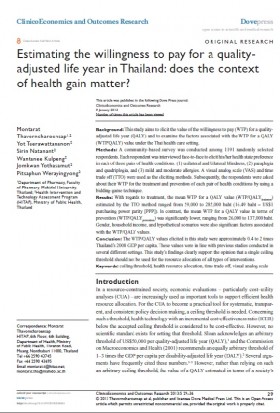This website uses cookies so that we can provide you with the best user experience possible. Cookie information is stored in your browser and performs functions such as recognising you when you return to our website and helping our team to understand which sections of the website you find most interesting and useful.
Estimating the willingness to pay for a quality-adjusted life year in Thailand: does the context of health gain matter? (2013)

รายละเอียดเพิ่มเติม
Estimating the willingness to pay for a quality-adjusted life year in Thailand: does the context of health gain matter?
Thavorncharoensap M1, Teerawattananon Y, Natanant S, Kulpeng W, Yothasamut J, Werayingyong P
1Department of Pharmacy, Faculty of Pharmacy, Mahidol University, Thailand ; Health Intervention and Technology Assessment Program (HITAP), Ministry of Public Health, Thailand.
Abstract
BACKGROUND:
This study aims to elicit the value of the willingness to pay (WTP) for a quality-adjusted life year (QALY) and to examine the factors associated with the WTP for a QALY (WTP/QALY) value under the Thai health care setting.
METHODS:
A community-based survey was conducted among 1191 randomly selected respondents. Each respondent was interviewed face-to-face to elicit his/her health state preference in each of three pairs of health conditions: (1) unilateral and bilateral blindness, (2) paraplegia and quadriplegia, and (3) mild and moderate allergies. A visual analog scale (VAS) and time trade off (TTO) were used as the eliciting methods. Subsequently, the respondents were asked about their WTP for the treatment and prevention of each pair of health conditions by using a bidding-game technique.
RESULTS:
With regards to treatment, the mean WTP for a QALY value (WTP/QALY(treatment)) estimated by the TTO method ranged from 59,000 to 285,000 baht (16.49 baht = US$1 purchasing power parity [PPP]). In contrast, the mean WTP for a QALY value in terms of prevention (WTP/QALY(prevention)) was significantly lower, ranging from 26,000 to 137,000 baht. Gender, household income, and hypothetical scenarios were also significant factors associated with the WTP/QALY values.
CONCLUSION:
The WTP/QALY values elicited in this study were approximately 0.4 to 2 times Thailand’s 2008 GDP per capita. These values were in line with previous studies conducted in several different settings. This study’s findings clearly support the opinion that a single ceiling threshold should not be used for the resource allocation of all types of interventions.
Full Text: http://www.ncbi.nlm.nih.gov/pubmed/23345984




